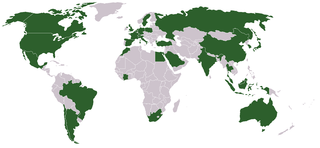
The economy of Pakistan is the 23rd largest in the world in terms of purchasing power parity (PPP), and 38th largest in terms of nominal gross domestic product. Pakistan has a population of over 207 million, giving it a nominal GDP per capita of $1,641 in 2018, which ranks 147th in the world and giving it s PPP GDP per capita of 5,709 in 2018, which ranks 130th in the world for 2018. However, Pakistan's undocumented economy is estimated to be 36% of its overall economy, which is not taken into consideration when calculating per capita income. Pakistan is a developing country and is one of the Next Eleven countries identified by Jim O'Neill in a research paper as having a high potential of becoming, along with the BRICS countries, among the world's largest economies in the 21st century. The economy is semi-industrialized, with centres of growth along the Indus River. Primary export commodities include textiles, leather goods, sports goods, chemicals, carpets/rugs and medical instruments.
A reserve currency is a currency that is held in significant quantities by governments and institutions as part of their foreign exchange reserves. The reserve currency is commonly used in international transactions, international investments and all aspects of the global economy. It is often considered a hard currency or safe-haven currency. People who live in a country that issues a reserve currency can purchase imports and borrow across borders more cheaply than people in other nations because they do not need to exchange their currency to do so.

The Asian financial crisis was a period of financial crisis that gripped much of East and Southeast Asia beginning in July 1997 and raised fears of a worldwide economic meltdown due to financial contagion.
The balance of payments, also known as balance of international payments and abbreviated B.O.P. or BoP, of a country is the record of all economic transactions between the residents of the country and the rest of the world in a particular period of time. The balance of payments is a summary of all monetary transactions between a country and rest of the world. These transactions are made by individuals, firms and government bodies. Thus the balance of payments includes all external visible and non-visible transactions of a country. It is an important issue to be studied, especially in international financial management field, for a few reasons.

The national debt of the United States was $22.03 trillion. This is the total debt, or unpaid borrowed funds, carried by the federal government of the United States, which is measured as the face value of the currently outstanding Treasury securities that have been issued by the Treasury and other federal government agencies. The terms national deficit and national surplus usually refer to the federal government budget balance from year to year, not the cumulative amount of debt. A deficit year increases the debt, while a surplus year decreases the debt as more money is received than spent.

External loan is the total debt a country owes to foreign creditors; its complement is internal debt which is owed to domestic lenders. The debtors can be the government, corporations or citizens of that country. The debt includes money owed to private commercial banks, other governments, or international financial institutions such as the International Monetary Fund (IMF) and World Bank. Note that the use of gross liability figures greatly distorts the ratio for countries which contain major money centers such as the United Kingdom due to London's role as a financial capital. Contrast with net international investment position.
The Mexican peso crisis was a currency crisis sparked by the Mexican government's sudden devaluation of the peso against the U.S. dollar in December 1994, which became one of the first international financial crises ignited by capital flight.
The reserve requirement is a central bank regulation employed by most, but not all, of the world's central banks, that sets the minimum amount of reserves that must be held by a commercial bank. The minimum reserve is generally determined by the central bank to be no less than a specified percentage of the amount of deposit liabilities the commercial bank owes to its customers. The commercial bank's reserves normally consist of cash owned by the bank and stored physically in the bank vault, plus the amount of the commercial bank's balance in that bank's account with the central bank.
Foreign-exchange reserves is money or other assets held by a central bank or other monetary authority so that it can pay its liabilities if needed, such as the currency issued by the central bank, as well as the various bank reserves deposited with the central bank by the government and other financial institutions. Reserves are held in one or more reserve currencies, mostly the United States dollar and to a lesser extent the Euro.
Money creation is the process by which the money supply of a country, or of an economic or monetary region, is increased. In most modern economies, most of the money supply is in the form of bank deposits. Central banks monitor the amount of money in the economy by measuring the so-called monetary aggregates.
"Irrational exuberance" is the phrase used by the then-Federal Reserve Board chairman, Alan Greenspan, in a speech given at the American Enterprise Institute during the dot-com bubble of the 1990s. The phrase was interpreted as a warning that the market might be overvalued.

In economics, the debt-to-GDP ratio is the ratio between a country's government debt and its gross domestic product (GDP). A low debt-to-GDP ratio indicates an economy that produces and sells goods and services sufficient to pay back debts without incurring further debt. Geopolitical and economic considerations – including interest rates, war, recessions, and other variables – influence the borrowing practices of a nation and the choice to incur further debt.
The United States subprime mortgage crisis was a nationwide financial crisis, occurring between 2007 and 2010, that contributed to the U.S. recession of December 2007 – June 2009. It was triggered by a large decline in home prices after the collapse of a housing bubble, leading to mortgage delinquencies and foreclosures and the devaluation of housing-related securities. Declines in residential investment preceded the recession and were followed by reductions in household spending and then business investment. Spending reductions were more significant in areas with a combination of high household debt and larger housing price declines.

The financial position of the United States includes assets of at least $269.6 trillion and debts of $145.8 trillion to produce a net worth of at least $123.8 trillion as of Q1 2014.
A global saving glut is a situation in which desired saving exceeds desired investment. By 2005 Ben Bernanke, chairman of the Federal Reserve, the central bank of the United States, expressed concern about the "significant increase in the global supply of saving" and its implications for monetary policies, particularly in the United States. Although Bernanke's analyses focused on events in 2003 to 2007 that led to the 2007–2009 financial crisis, regarding GSG countries and the United States, excessive saving by the non-financial corporate sector (NFCS) is an ongoing phenomenon, affecting many countries. Bernanke's "celebrated " global saving glut (GSG) hypothesis argued that increased capital inflows to the United States from GSG countries were an important reason that U.S. longer-term interest rates from 2003 to 2007 were lower than expected.
Original sin is a term in economics literature, proposed by Barry Eichengreen, Ricardo Hausmann, and Ugo Panizza in a series of papers to refer to a situation in which "most countries are not able to borrow abroad in their domestic currency."
In monetary policy of the United States, the term Fedspeak is what Alan Blinder called "a turgid dialect of English" used by Federal Reserve Board chairmen in making wordy, vague, and ambiguous statements. The strategy, which was used most prominently by Alan Greenspan, was used to prevent financial markets from overreacting to the chairman's remarks. The coinage is an intentional parallel to Newspeak of Nineteen Eighty-Four, a novel by George Orwell.
The Great Recession in the United States was a severe financial crisis combined with a deep recession. While the recession officially lasted from December 2007 to June 2009, it took several years for the economy to recover to pre-crisis levels of employment and output. This slow recovery was due in part to households and financial institutions paying off debts accumulated in the years preceding the crisis along with restrained government spending following initial stimulus efforts. It followed the bursting of the housing bubble, the housing market correction and subprime mortgage crisis.
The external debt is the amount of debt a country owes to foreign or international creditors. The debtors can be the government, corporations or citizens of that country. The estimated Philippines foreign debt under the Aquino administration in early 2016 was US$110000.







